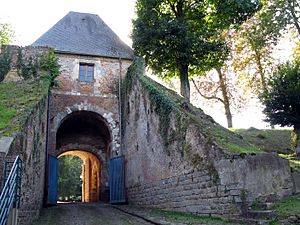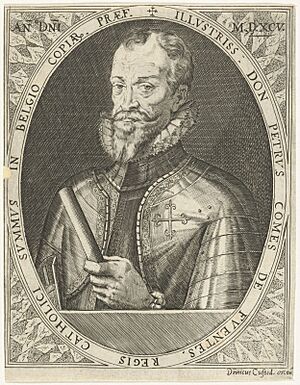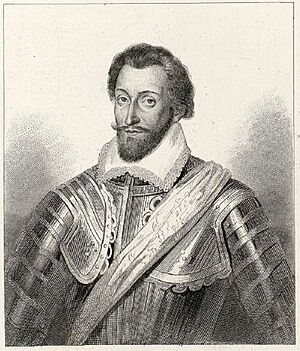Siege of Doullens facts for kids
Quick facts for kids Siege of Doullens |
|||||||
|---|---|---|---|---|---|---|---|
| Part of the Franco-Spanish War (1595-1598) | |||||||
 View of the citadel of Doullens. |
|||||||
|
|||||||
| Belligerents | |||||||
| Commanders and leaders | |||||||
| Strength | |||||||
| Unknown | 8,000 | ||||||
| Casualties and losses | |||||||
| At least 6,000 dead or captured | Unknown | ||||||
The Siege of Doullens was an important battle during the Franco-Spanish War (1595-1598). It happened between July 14 and July 31, 1595, in Doullens, Picardy, France. This war was part of the larger French Wars of Religion.
After about ten days, French forces tried to help the city. These forces were led by the Duke of Bouillon, Admiral Villars, and François d'Orléans-Longueville. However, they were badly defeated by the Spanish army. The Spanish forces were led by Don Pedro Henríquez de Acevedo, Count of Fuentes and Don Carlos Coloma.
Admiral Villars was captured and killed. The Duke of Bouillon and the rest of the French army escaped to Amiens. A few days later, on July 31, the Spanish troops attacked and took Doullens. They killed many people in the city, both soldiers and civilians. They shouted "Remember Ham!" This was to get revenge for a previous attack on a Spanish group in Ham by French and Protestant soldiers.
Contents
Why the Siege Happened
During the French Wars of Religion, Spain often helped the Catholic League in France. Spain supported Catholics because they were also a Catholic country. For example, in 1590, Spain helped defeat Henry of Navarre (who later became King Henry IV) during the siege of Paris.
This Spanish success led Henry to become Catholic. He famously said, "Paris is well worth a Mass." With most of his Catholic subjects supporting him, he became King of France in 1594. In 1595, King Henry IV officially declared war on Spain. Spain was trying to take back parts of northern France.
In the Low Countries (modern-day Netherlands and Belgium), Don Pedro Henríquez de Acevedo, Count of Fuentes became the temporary leader of the Spanish Netherlands in February 1595.
In June 1595, French and Protestant forces, led by the Duke of Bouillon and François d'Orléans-Longueville, captured Ham. They killed the small Spanish group there. Meanwhile, the Count of Fuentes led his Spanish army into France. He had about 5,000 soldiers. They captured Le Catelet. Fuentes then got 3,000 more soldiers. On July 14, he reached Doullens and began the siege.
When the French leaders heard about Doullens, Bouillon and François d'Orléans joined forces with Admiral Villars. Their combined army marched to help Doullens. The French soldiers defending Doullens prepared well, hoping help would arrive soon. On July 16, Valentín Pardieu de la Motte, a Spanish commander, was killed by a shot while checking Doullens' defenses.
The Battle and Its Outcome

On July 24, the French army arrived near Doullens. Admiral Villars, leading the French relief army, rushed to help the town. He did not wait for more soldiers to arrive. Fuentes sent about 2,000 to 3,000 men, led by Don Carlos Coloma, to stop the French.
Villars launched a risky cavalry attack against the Spanish. This caused some confusion among the Spanish troops. But the Spanish quickly pushed them back, causing many French soldiers to be killed. The Spanish then surrounded the French army. Fuentes's forces severely defeated them. They captured their weapons, supplies, and flags.
Villars was taken prisoner. Even though he offered to pay money for his freedom, he was killed. This defeat further weakened King Henry IV's army in Picardy. The Duke of Bouillon escaped to Amiens with the remaining French soldiers.
Taking Doullens by Force
Fuentes then turned his attention back to Doullens. After two failed attempts, his army successfully took the city on July 31. The Spanish soldiers shouted "Remember Ham!" as they entered. They killed many people in the city, both soldiers and civilians. This was revenge for the earlier attack on the Spanish group in Ham by French and Protestant soldiers. Between 3,000 and 4,000 people died in just a few hours.
What Happened Next

With Doullens now under Spanish control, Fuentes received 1,500 more soldiers. These new troops were led by Charles Bonaventure de Longueval, Count of Bucquoy. Fuentes then moved his main army towards the important fortress-city of Cambrai.
King Henry IV, who was in Lyon, wanted to save Cambrai at all costs. However, he did not have enough money to gather a new army. He even asked the United Provinces for military help, but their response was very slow. After a strong attack, the Spanish army captured Cambrai. The leader of Cambrai, Jean de Monluc, surrendered on September 7.
Doullens remained under Spanish control until the Peace of Vervins was signed in 1598.
See also
 In Spanish: Asedio de Doullens para niños
In Spanish: Asedio de Doullens para niños
- French Wars of Religion
- Siege of Calais (1596)
- Catholic League of France
- List of Governors of the Spanish Netherlands


